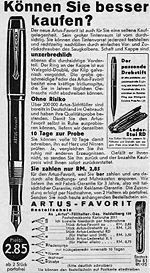Differenze tra le versioni di "Lamy/en"
(Aggiornamento come da nuova versione della pagina di origine) |
|||
| Riga 24: | Riga 24: | ||
Only in [[1952]] the company put on the market the first pen marked [[Lamy]], the [[Lamy 27]] model, with [[piston filler]] and demi-covered nib, tapered shapes with a style that is reminiscent of the [[Parker 51]], which at that time saw countless imitators. Despite the similarity, the [[Lamy 27]] was a pen with its own clear personality, and presented considerable technical innovation, like the particular feeder, referred to as ''[[Tintomatic]]'', which is still used today for its characteristic to ensure a constant flow of ink despite changes in temperature and pressure, thanks to the micro inlays around the feed. | Only in [[1952]] the company put on the market the first pen marked [[Lamy]], the [[Lamy 27]] model, with [[piston filler]] and demi-covered nib, tapered shapes with a style that is reminiscent of the [[Parker 51]], which at that time saw countless imitators. Despite the similarity, the [[Lamy 27]] was a pen with its own clear personality, and presented considerable technical innovation, like the particular feeder, referred to as ''[[Tintomatic]]'', which is still used today for its characteristic to ensure a constant flow of ink despite changes in temperature and pressure, thanks to the micro inlays around the feed. | ||
| − | + | In [[1966]] the company created what is considered its masterpiece, the [[Lamy 2000]]. For the realization of this pen the [[Lamy]] turned to ''Gerd A. Müller'' a famous industrial designer who followed the [http://it.wikipedia.org/wiki/Bauhaus Bauhaus] stylistic movement for which the shape follows the function. The pen was made in [[Makrolon]], a polycarbonate plastic resin reinforced with glass fibers, a revolutionary material for the epoch. Equipped with a [[piston filler]] the pen is considered one of the best examples of modern design for the simplicity of the lines and the functionality of the realization. | |
Negli anni successivi la [[Lamy]] ha sempre mantenuto una costante ricerca nello stile e nella realizzazione penne funzionali e robuste. Senza puntare alla ricerca dell'oggetto di lusso esclusivo (dal costo proibitivo), ma senza neanche scadere nella cultura dell'usa e getta al minimo costo (e valore) possibile, la [[Lamy]] è riuscita a restare sul mercato degli strumenti di scrittura proprio grazie alla sua capacità di creare penne di design moderno e di elevata qualità costruttiva, ed oggi risulta essere il principale produttore tedesco di articoli da scrittura. | Negli anni successivi la [[Lamy]] ha sempre mantenuto una costante ricerca nello stile e nella realizzazione penne funzionali e robuste. Senza puntare alla ricerca dell'oggetto di lusso esclusivo (dal costo proibitivo), ma senza neanche scadere nella cultura dell'usa e getta al minimo costo (e valore) possibile, la [[Lamy]] è riuscita a restare sul mercato degli strumenti di scrittura proprio grazie alla sua capacità di creare penne di design moderno e di elevata qualità costruttiva, ed oggi risulta essere il principale produttore tedesco di articoli da scrittura. | ||
Versione delle 23:36, 20 gen 2015
Although Lamy, being born in 1930, appears to be one of the historic German producers, is often seen as a recently founded company. But since the '60s its models have always been characterized by the attention to design and design research, with the production of great value models like the Lamy 2000 that, for their futuristic and minimalist style, have earned the company an image of modernity and avant-garde.
Having always invested in research and development, the company has been able to successfully overcome the crisis period following the ballpoint pen introduction, keeping up with the times and adapting to new market demands, on which it remained continuously present from the foundation. To date Lamy stands out as a manufacturer of midrange fountain pens, and writing tools for everyday use. Although the company has chosen not to produce luxury models, his fountaon pens are of excellent quality and maintain that particular attention to stylistic innovation that makes them always relevant and interesting.
| Lamy |
|---|
| Brand pages |
| Brand advertising |
| Brand photos |
| Instructions sheet |
| Other documents |
| Patents |
History
The Lamy was born at the hands of Joseph C. Lamy in 1930 in Heidelberg, under the name of Orthos Fullhalterfabrik C. J. Lamy. Joseph C. Lamy had been director of the exports of Parker until the 20's. In 1927 he returned to Heidelberg as Parker Germany' general manager in the period in which it had acquired the Osmia for the Duofold production in Germany.
At the end of 1929, more or less simultaneously with Osmia discharge by Parker , Joseph Lamy resigned to create his company. He moved to Berlin and began production of celluloid pens marked Orthos, very similar to Duofold (which at that time was much imitated) produced in two sizes and a wide range of colors.
In 1933 Lamy acquired a first patent for a pen/pencil combination, and put into production a large pen, always meant to compete with the Duofold. There is little information on these years, and specific models are not known, the pens were simply marketed under the brand Orthos.

Inoltre Joseph C. Lamy seppe presagire i tempi intuendo le potenzialità della plastica, ed acquisì la Artus Fullaltergesellschaft Kaufmann und Co, le cui origini sembrano risalire al 1936/37, iniziando, per primo in Europa, a produrre penne in plastica a iniezione. Il primo modello era realizzato con un nuovo meccanismo a stantuffo brevettato e pur restando commercializzato con il marchio Artus si distingueva chiaramente dai predecessori.
It is unclear whether the production of plastic pens began around 1939, approximate date of the acquisition of Artus, or only after the war. It is not clear even when it ceased to use the Orthos trademark, but at least until 1941 [1] the brands coexisted sharing address and phone number, even during a change of venue took place in 1940.
Negli anni successivi la gamma venne ampliata con nuovi modelli come le Artus Rekord, Perfect, Favorit, Ballit, Schulüller, Prinz, Junior. La Artus si concentrò nella produzione di penne economiche e funzionali, con una attenzione al mercato studentesco; seppe inoltre spaziare in tutto l'arco degli strumenti da scrittura. Inoltre l'azienda si distinse per la scelta di una diffusione commerciale basata sulla vendita diretta via posta, scavalcando la rete dei rivenditori di materiali di cancelleria. Nel 1949 la Artus venne rinominata in Artus, C. Josef Lamy, ed il marchio continuò ad esistere fino al 1972.
Only in 1952 the company put on the market the first pen marked Lamy, the Lamy 27 model, with piston filler and demi-covered nib, tapered shapes with a style that is reminiscent of the Parker 51, which at that time saw countless imitators. Despite the similarity, the Lamy 27 was a pen with its own clear personality, and presented considerable technical innovation, like the particular feeder, referred to as Tintomatic, which is still used today for its characteristic to ensure a constant flow of ink despite changes in temperature and pressure, thanks to the micro inlays around the feed.
In 1966 the company created what is considered its masterpiece, the Lamy 2000. For the realization of this pen the Lamy turned to Gerd A. Müller a famous industrial designer who followed the Bauhaus stylistic movement for which the shape follows the function. The pen was made in Makrolon, a polycarbonate plastic resin reinforced with glass fibers, a revolutionary material for the epoch. Equipped with a piston filler the pen is considered one of the best examples of modern design for the simplicity of the lines and the functionality of the realization.
Negli anni successivi la Lamy ha sempre mantenuto una costante ricerca nello stile e nella realizzazione penne funzionali e robuste. Senza puntare alla ricerca dell'oggetto di lusso esclusivo (dal costo proibitivo), ma senza neanche scadere nella cultura dell'usa e getta al minimo costo (e valore) possibile, la Lamy è riuscita a restare sul mercato degli strumenti di scrittura proprio grazie alla sua capacità di creare penne di design moderno e di elevata qualità costruttiva, ed oggi risulta essere il principale produttore tedesco di articoli da scrittura.
Cronologia
| Anno | Avvenimento |
|---|---|
| 1930 | l'azienda viene fondata da Joseph C. Lamy a Heidelberg come Orthos Fullhalterfabrik C. J. Lamy |
| 1939 | l'azienda acquisisce la Artus Fullaltergesellschaft Kaufmann und Co (data incerta) |
| 1939 | l'azienda introduce le Favorit (data incerta) |
| 1952 | l'azienda introduce le Lamy 27 |
| 1966 | l'azienda introduce le Lamy 2000 |
| 1967 | l'azienda dismette le Artus Prinz |
Riferimenti esterni
- [1] Sito ufficiale dell'azienda
- [2] Sito dedicato alla storia della Lamy, inattivo
- [3] Articolo sulla Lamy
- [4] Articolo e discussione sulla Lamy 27
- [5] Articolo e discussione sulla Lamy 2000
- [6] Storia del design, dal sito dell'azienda
Note
- ↑ at least as reported in this discussion.
